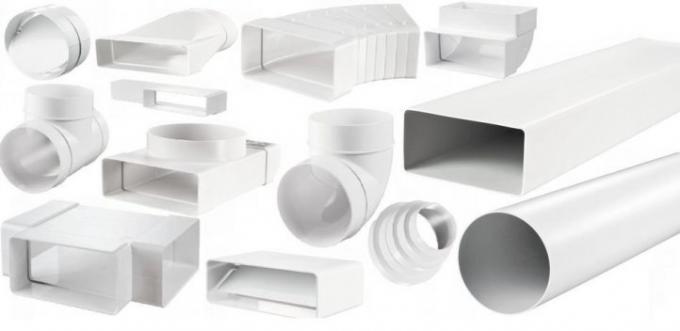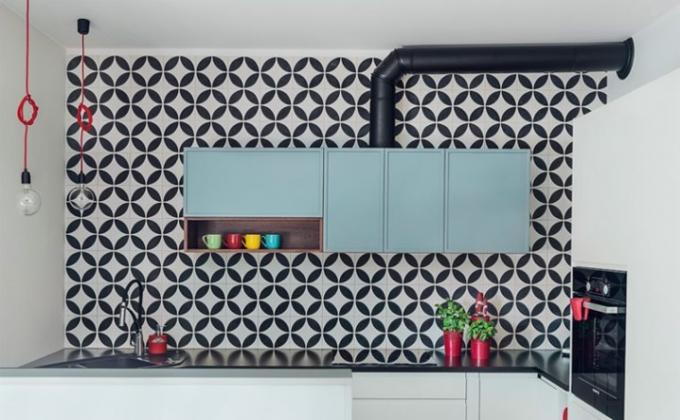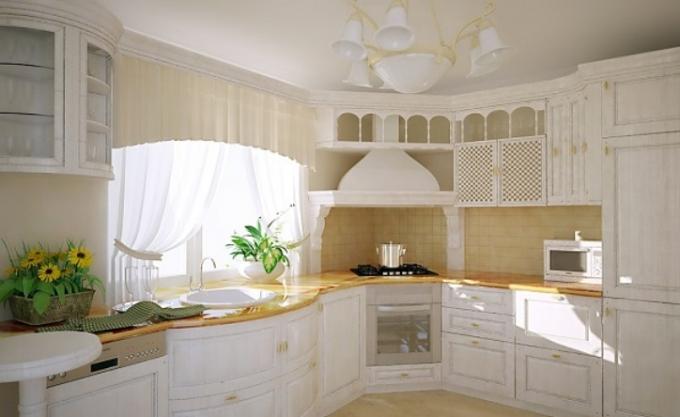Content
-
1 Types of air ducts: advantages and disadvantages of materials
- 1.1 Aluminum
- 1.2 Plastic
- 2 Selection of the size and diameter of the duct
- 3 Duct masking options
- 4 Finally
The cooker hood is one of the most useful appliances in the kitchen to keep the air in the room clean and fresh. Its performance directly depends on how correctly the exhaust pipe is selected. We will tell you about what an air duct is and about the materials from which it is made, as well as what to look for when choosing a pipe, in our article.

Without a properly selected duct, the extraction efficiency decreases
Types of air ducts: advantages and disadvantages of materials
Choosing a hood for the kitchen - It's not a problem. There are many models from dozens of manufacturers these days. But what to do if the ventilation duct in the kitchen is located at a distance from the stove location? But it is above the plate that install a kitchen hood. In this situation, a special kitchen hood pipe will come in handy.

Exhaust pipes may differ not only in shape and size, but also in materials.
Pipes designed to remove air flow from the kitchen can be made of aluminum or plastic. Both of these options have their own advantages and disadvantages, which should be familiarized with before buying a product. Let's dwell on this point in more detail.
Aluminum
The corrugated pipe for the cooker hood (popularly called "corrugation") is made of semi-rigid aluminum. Outwardly, it looks like accordion fur, which, if necessary, can be stretched to the required size.

Corrugated pipes are made from semi-rigid aluminum
Benefits. The main advantage of the corrugation is its ease of installation, which is achieved due to the ability to bend the element at any angle. The pipe is available with various types of cross-section, which allows you to choose an option for any configuration of the hood. The material is able to easily withstand temperatures up to 250 degrees, which makes it resistant to melting and fire.

If necessary, the size of the corrugation can be corrected with ordinary scissors.
disadvantages. One of the main disadvantages of corrugation is its unattractive appearance, which can ruin even the most sophisticated interior. The presence of many folds provokes an abundant accumulation of dust and dirt on the surface, which is very problematic to remove. It is also worth remembering that having once stretched the corrugation to its entire length, it will be very difficult to assemble it back into an accordion. When reassembling the structure, the tightness of the connection may be compromised.

The appearance of the corrugation can significantly spoil the interior
Plastic
The plastic pipe for the hood to the kitchen is a smooth rigid structure, the section of which is made in the form of a rectangle or circle.

Plastic pipes are made with round or rectangular sections
Benefits. Due to the smooth surface, plastic pipes do not accumulate dirt, and besides, washing them with your own hands is very easy. Such structures do not make noise during operation, it is not difficult to disguise them. The plastic is strong enough and resistant to the high levels of moisture that prevails in the kitchen.

To install a plastic duct, you will have to buy additional corners and spare parts
disadvantages. Quite high price in comparison with aluminum counterparts. In addition, the installation of a plastic pipe is not as easy as that of a corrugation. In the process, it will be necessary to use additional adapters and corner elements that will help maintain the tightness of all joints.
Selection of the size and diameter of the duct
The correct calculation of the duct pipe is just as important a point as the selection of material and type of construction. An error in calculations can significantly reduce the productivity of the hood, increase the noise level during its operation, and increase the load on the functional elements of the device. All this can lead to damage to the hood and its costly repair.

An incorrectly sized duct will reduce the efficiency of the hood
In order for the duct connection to be successful, the following nuances must be taken into account:
- Diameter. When choosing the diameter of the air duct, first of all, it is necessary to rely on the diameter of the exhaust pipe. The pipe should not be less than its size, an exact match is desirable. In the event that the ventilation duct of the house has a smaller diameter than the hood opening, then it simply does not make sense to install a larger diameter duct.

The size of the duct may slightly exceed the diameter of the ventilation, but in no way be smaller than it
The minimum indicator for this parameter is 80 mm. Due to the fact that the dimensional step is 10 mm (for example, there are options with a diameter of 90, 100, 110 mm), choosing the right material is not difficult. Most often in kitchens, exhaust pipes with a diameter of 180 or 200 mm are used.
- Length. The ventilation pipe should not be too long (maximum 3 meters) or curved, because each turn of the pipeline through an angle of 90 degrees leads to a decrease in the overall performance of the system by 10%. If the bend exceeds an angle of 90 degrees, overloading of the motor and improper air outflow may occur.

The more angles the connected pipe has, the lower the extraction performance
When carrying out installation work, remember that the optimum duct length is 3m. If you need a longer pipe, remember that each additional meter above the norm reduces the efficiency of the hood by 5-10%. If we talk about the optimality of the section, as well as the material, then it should be noted here that a round pipe with smooth walls is considered the most appropriate choice.
Duct masking options
In order not to violate the integrity of the interior and not to spoil the appearance of the kitchen, the question often arises of how to hide the pipe from the hood in the kitchen. There are several very neat solutions.
- Masking box. The decorative box will easily hide both plastic and aluminum ducts. To install it, the first step is to build a frame of metal profiles, corners and screws. Fastening the unit to a wall or ceiling, the frame is sheathed with sheets of moisture-resistant plasterboard.

Thanks to a masking box made of plasterboard or plastic, the kitchen interior will remain complete
See also: Hood boxes in the kitchen: features, materials and installation instructions
- Plastic panels. The instructions for installing them are almost the same as for the masking box. The only difference is that plastic panels are used instead of drywall. This solution looks especially organic if the ceiling in the kitchen is also trimmed with plastic.
- Painting. It should be noted that painting the pipe in the color of interest is available only if it is made of plastic. This option will not work with corrugation.

Painting the pipe to match the color of the finish (example in the photo) is one of the simplest masking options
- Furniture visor. If you still have not purchased a kitchen set, then it may be worth considering that its upper part has a kind of visor. It will successfully hide the pipe laid between the upper cabinets and the ceiling.
- Protruding ceiling. A protruding stretch ceiling will look impressive, but it has one big drawback. If you need to get to the pipe, the ceiling will have to be disassembled and reassembled.

If you need to get access to the ventilation pipe, the ceiling will have to be disassembled
Finally
We told you about the types of air ducts and their features, as well as ways to mask them. As you may have noticed, choosing a pipe for an exhaust hood is not such a difficult task, you just need to correctly approach its implementation. Be sure to watch the video in the article, with its help you will learn how to install an air duct in your kitchen.


